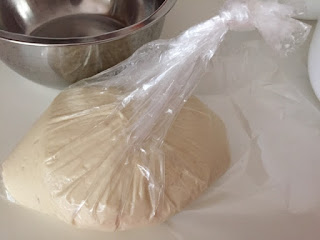Pain de Mie, a French white bread, which uses simple ingredients to bake a tender and slightly chewy bread.
I adapted the recipe from a renowned Taiwanese baker, 王传仁,who recommended adding icy cold water to the dough instead of room temperature water.
I tried this popular recipe using my new Mayer bread maker "Mix Dough" function to knead, and later let the dough underwent cold fermentation process in the fridge. The result was a bread with good texture that could last for more than two days. Beyond that could not tell, as the delicious bread has been gobbled up :)
Yield: one 20x10x15cm bread
Raw dough weight: 574g
Bread Weight: 519 g
Pan size:
20x10x10cm Pullman tin
Baking temperature & Time:
170 degree Celsius for 50 minutes at lower rack
Ingredient A
For natural yeast recipe, follow the green prints, or else follow the black prints.
180~190g (170g) cold water 冰水*
25g fine sugar 细砂糖
1/2 tsp salt 盐 ~4g
10g rice bran/veggie oil 米糠油/植物油
20g cold unsalted butter 冷无盐奶油
Ingredient B
300g (290g) Prima bread flour 百龄麦高筋面粉
12g milk powder 奶粉
Ingredient C
3/4 (1/4) tsp instant dry yeast 即发干酵母
50g natural yeast (100% hydration) 天然酵母
* If using Prima brand flour, add 190g
If using Origin brand flour,add 180g
of water
From my experience, Prima flour produces a better elastic and smoother dough for this recipe.
Directions
1. Pour ingredient A into the bread pan.
2. Add ingredient B above ingredient A.
3. Dig a hole in the centre of the flour, and pour ingredient C in.
Just pour the natural yeast along the edge of the flour.
4. Select "C-11 Ferment Dough" function and press start. Although the process will take about 1:30 hour to complete, stop the process at around 0:44 hour after the kneading blade has made 5 turns to turn the dough.
1 minute before the kneading blade start to turn.

The kneading blade was in the process of turning.

At the end of the 5 turns.

5. After the program ends, transfer the dough to a plastic bag pre-coated with a little oil.
Tie the plastic bag with a loose knot.
To prevent moisture loss in the fridge, keep the dough in another plastic bag.
For natural yeast recipe, allow the dough to stay in room temperature for about 1 hour before placing in the fridge to undergo cold fermentation.

Finally, place the dough in a bowl and wrap with a 3rd plastic bag or lid. Store the dough in a fridge for 12 hours at least.
I stored it for about 18 hours.
6. Transfer the cold dough out of the fridge. Remove the two external plastic bags, and allow the dough to thaw for about 1/2 to an hour.
7. While waiting for the dough to thaw, apply a thin coat of butter on the Pullman tin interior walls.
8. Cut open the plastic bag, and turn the dough onto a floured work top.
Wear a pair of disposable gloves to handle the slightly sticky dough.
9. Flatten the dough to release the trapped air. Divide the dough into 3 equal portions, about 189g each.
10. Shape the dough into 3 balls by pulling down the sides, and seal at the bottom.
Cover and let them rest for about 15 min.
11. Flatten the dough and roll out into a flat oval dough.
12. Roll up the dough from the shorter side, cover with a lid, and let it rest for 10 minutes.
13. After the rest, roll out the dough into a flat dough again. The shorter length of the dough should correspond to the shorter width of the Pullman tin.
14. Flip the dough over so the smoother side will be facing out after rolling up. Roll up the dough from the shorter end.
Place the dough into a greased non-stick Pullman tin. The open end of the dough should be facing down.
15. Spray some water over the dough and place the doughs in a closed oven.
Let the dough proof in a warm oven for about 60 to 85 (90~100) minutes, or till the dough reaches about the rim of the Pullman tin.
To facilitates the second proofing, you may switch on the oven to its minimal temperature for about 1 minute.
16. After the second proofing and the dough has reached about the rim of the Pullman tin, remove the dough out of the oven. Preheat the oven to 170 degree Celsius. And brush a coat of fresh milk over the dough.
17. Bake the dough at the lower rack of the oven at 170 degree Celsius for about 50 minutes. If your Pullman tin has a thinner wall, you can bake for about 40 minutes at the same temperature.
18. Remove the bread from the Pullman tin immediately after leaving the oven. Let the loaf cool down on a wire rack before slicing it.
19. Slice with a bread knife :)
A thin spread of butter is the best way to enjoy the good flavour of the fresh bread :)
3rd day softness test
The crumb of the bread was still soft, though the exposed surface lose a bit of moisture.
Enjoyed it toasted with a thin coat of butter and some sprinkled sugar. Yum ~
For Valentine's Day, I bake the bread with some heart shapes prints.
Just cut some heart shapes using parchment paper. Wet the cut heart shapes with some sprays of water, then rest them on the desired positions on the dough surface.
Sprinkle some bread flour over the top, remove the heart-shaped papers. Sprinkle a little flour over the bare spots just before baking :)
Just cut some heart shapes using parchment paper. Wet the cut heart shapes with some sprays of water, then rest them on the desired positions on the dough surface.
Sprinkle some bread flour over the top, remove the heart-shaped papers. Sprinkle a little flour over the bare spots just before baking :)




































































